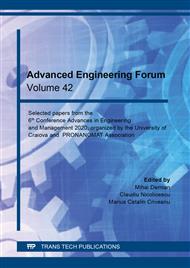p.79
p.85
p.91
p.99
p.107
p.113
p.122
p.128
p.137
Portable Abdominal Insufflation Device for Stopping Uncontrolled Abdominal Bleeding in Trauma Cases
Abstract:
Needle insertion in biological tissue has attracted considerable attention due to its application in minimally invasive procedures such as laparoscopy or transcutaneous biopsy. In this paper the force of the Veress needle insertion into the abdominal wall and the von Mises stress were studied, demonstrating the ability of finite element models to provide additional understanding of the processes taking place. Veress needle insertion force may cause complications during surgery, the most common being vascular lesions, thus affecting the precision and duration of surgery assisted by a portable abdominal insufflation device. This study was the first step in developing a force feedback for needle insertion into the abdominal wall assisted by a portable abdominal insufflation device. The CAD model of the prototype of a portable abdominal insufflation device was made. Then the prototype of a portable abdominal insufflation device was developed. For testing purposes an artificial silicone model was made. The paper also includes the experimental results obtained by measuring the maximum pressure inside the artificial silicone model after the penetration of the wall.
Info:
Periodical:
Pages:
107-112
Citation:
Online since:
September 2021
Authors:
Keywords:
Price:
Сopyright:
© 2021 Trans Tech Publications Ltd. All Rights Reserved
Share:
Citation:


